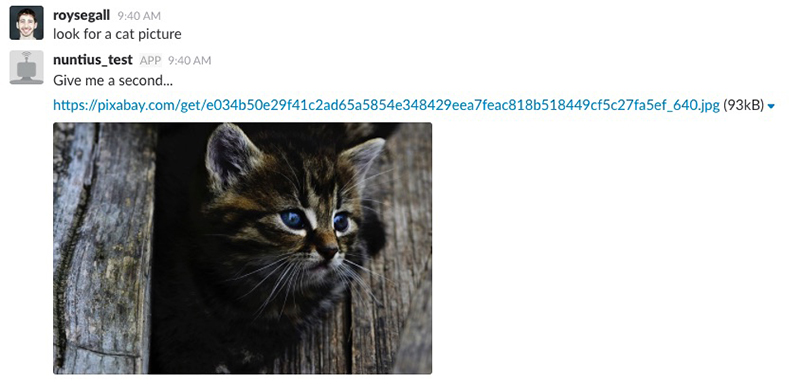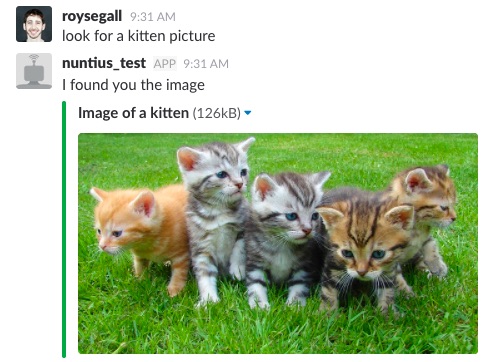In case you haven’t noticed, we are on the verge of a new era - the bot era!!
[Dramatic music in the background]
Sort of… Mark Zuckerberg showed us what it could really be. Though, we need to understand that for now, bots are more like what Dries showed us in his keynote at DrupalCon Baltimore.
Ro-bot 101
So what is a bot? If you’ve ever said Hey Siri, OK Google, Hey Cortona, or Alexa,
then you have interacted with a bot. That bot received an input, returned an output -
it woke you up, reminded you of something, sent an email, or ordered
a new book from Amazon - and you if you’re lucky, a drone delivered it!
Platforms and technologies
Now that we understand what a bot is, let’s start to see how we can write one. Any chat platform provide bots, and there are two ways for them to communicate:
- Web sockets - Though we use this technology for push events to the user’s browser, platforms provide a web socket channel and push events when something happens in a channel in which your bot is listening.
- Web hooks - In this case you get http requests with the information on events.
Slack, Facebook Messenger, Skype, and Telegram all provide integrations with bots in one way or another, but in this post we will focus on Slack.
Writing Your First Bot is Easier than You Think
First, create a bot in your team. You can do it under
http://yourteam.slack.com/apps and create a custom bot integration.
Next you’ll need to start with a library. There’s something like a quadrillion libraries - PHP, NodeJS, Python, and couple in Go lang. For our purposes, we need an easy setup, listening to events and acting, understanding from the text what kind of task the user requires, and even more (cron tasks for reminders, incoming web hooks, DB layer, etc.). Sounds a bit daunting, no? You’re right!
When I started to write the first task, I saw that analyzing the text is more than just matching a function to the text. When there are a lot of tasks, the code will get long and messy. And that’s why I created Nuntius: a PHP framework based on Symfony components that helped me organize the code.
Introducing Nuntius
Though Nuntius is well-documented, let’s see how easy is to set up a task. After settings up nuntius we need to write the first task.
Hooks? Event dispatching?
No and no. To make things easy, Nuntius does not use hooks or events dispatching to integrate with custom code. Instead, all of the integrations defined in a YML file.
In our hooks.local.yml we will add a custom task:
Our task will be located at src/Custom/LookForAPicture.php:
After implementing the task, we can start to code. So, what should this task do? Get a keyword, look for an image which relates to that keyword, and send it as an attachment to the message. When you are feeling down you could ask for a picture of a cute kitten to take away your sorrow.
We will need to search for pictures via a REST request. I found a nice service for that: pixabay. You’ll need to register and get an API key.
After acquiring the access token, we need to store it somewhere. The best place
would be in the credentials.local.yml which located under the settings
library:
Let’s have a look at the code to get the picture:
What we need to do is to return the image URL, and that’s it! This the full code:
And this is the result:

But Wait, There’s More!
Slack was kind and embedded the picture for us, but it’s not the best practice. Using attachments makes the message much more readable and gives us this:

The code is a bit more complex than the simple URL we returned:
External Services
Your mind was blown, I know. But what’s next? If you thought that this branch of development is left without any SAAS solution, you are wrong. Bots need to interact with people and require deep learning and natural language analysis. There are two famous players in the market (for now) - api.ai and wit.ai.
In a nutshell, they will give you informative object to interact with and train with deep learning.
Is That the End?
No. Skynet is not around the corner, and HAL 9000 isn’t going to be in NASA’s new spaceships. This is just the beginning. Unless you are a big company like Apple, Google, or Facebook you probably won’t provide a solution like Siri and other bots.
Bots, as I can see it, will be another interaction with the product and can provide a simple way to get information like:
- When are you going launch the new version?
- Let users know that the site is under maintenance for now, and when it’s back.
- Notify the user when a new season of a TV show is going to launch (I was informed about Silicon Valley new season via Facebook Messenger.)
Don’t forget that QA was once done pretty much manually. Now, QA is automated but still need to be written and maintained. We might be killing one field but creating a new field.